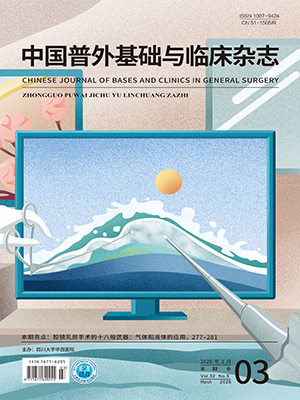| 1. |
Araújo F, Gouvinhas C, Fontes F, et al. Trends in cardiovascular diseases and cancer mortality in 45 countries from five continents (1980-2010). Eur J Prev Cardiol, 2014, 21(8): 1004-1017.
|
| 2. |
Chen W, Zheng R, Baade PD, et al. Cancer statistics in China, 2015. CA Cancer J Clin, 2016, 66(2): 115-132.
|
| 3. |
Bjørge T, Lukanova A, Jonsson H, et al. Metabolic syndrome and breast cancer in the me-can (metabolic syndrome and cancer) project. Cancer Epidemiol Biomarkers Prev, 2010, 19(7): 1737-1745.
|
| 4. |
Kitahara CM, Berrington de González A, Freedman ND, et al. Total cholesterol and cancer risk in a large prospective study in Korea. J Clin Oncol, 2011, 29(12): 1592-1598.
|
| 5. |
Melvin JC, Seth D, Holmberg L, et al. Lipid profiles and risk of breast and ovarian cancer in the Swedish AMORIS study. Cancer Epidemiol Biomarkers Prev, 2012, 21(8): 1381-1384.
|
| 6. |
Strohmaier S, Edlinger M, Manjer J, et al. Total serum cholesterol and cancer incidence in the Metabolic syndrome and Cancer Project (Me-Can). PLoS One, 2013, 8(1): e54242.
|
| 7. |
Chen Y, Wen YY, Li ZR, et al. The molecular mechanisms between metabolic syndrome and breast cancer. Biochem Biophys Res Commun, 2016, 471(4): 391-395.
|
| 8. |
《乳腺癌 HER2 检测指南 (2014 版)》编写组. 乳腺癌 HER2 检测指南 (2014 版). 中华病理学杂志, 2014, 43(4): 262-267.
|
| 9. |
《乳腺癌雌、孕激素受体免疫组织化学检测指南》编写组. 乳腺癌雌、孕激素受体免疫组织化学检测指南. 中华病理学杂志, 2015, 44(4): 237-239.
|
| 10. |
薛卫成. 介绍乳腺癌 TNM 分期系统(第 7 版). 诊断病理学杂志, 2010, 17(4): 241-244.
|
| 11. |
Coates AS, Winer EP, Goldhirsch A, et al. Tailoring therapies-improving the management of early breast cancer: St Gallen International Expert Consensus on the Primary Therapy of Early Breast Cancer 2015. Ann Oncol, 2015, 26(8): 1533-1546.
|
| 12. |
中国成人血脂异常防治指南修订联合委员会. 中国成人血脂异常防治指南(2016 年修订版). 中国循环杂志, 2016, 31(10): 937-950.
|
| 13. |
Wulaningsih W, Vahdaninia M, Rowley M, et al. Prediagnostic serum glucose and lipids in relation to survival in breast cancer patients: a competing risk analysis. BMC Cancer, 2015, 15: 913.
|
| 14. |
Esposito K, Chiodini P, Capuano A, et al. Metabolic syndrome and postmenopausal breast cancer: systematic review and meta-analysis. Menopause, 2013, 20(12): 1301-1309.
|
| 15. |
Wang M, Cheng N, Zheng S, et al. Metabolic syndrome and the risk of breast cancer among postmenopausal women in North-West China. Climacteric, 2015, 18(6): 852-858.
|
| 16. |
Martin LJ, Melnichouk O, Huszti E, et al. Serum lipids, lipoproteins, and risk of breast cancer: a nested case-control study using multiple time points. J Natl Cancer Inst, 2015, 107(5): 1-9.
|
| 17. |
His M, Dartois L, Fagherazzi G, et al. Associations between serum lipids and breast cancer incidence and survival in the E3N prospective cohort study. Cancer Causes Control, 2017, 28(1): 77-88.
|
| 18. |
魏丽娟, 张弛, 张寰, 等. 血脂代谢水平与乳腺癌发病风险的病例-对照研究. 中华预防医学杂志, 2016, 50(12): 1091-1095.
|
| 19. |
Collaborative Group on Hormonal Factors in Breast Cancer. Menarche, menopause, and breast cancer risk: individual participant meta-analysis, including 118 964 women with breast cancer from 117 epidemiological studies. Lancet Oncol, 2012, 13(11): 1141-1151.
|
| 20. |
Yang XR, Chang-Claude J, Goode EL, et al. Associations of breast cancer risk factors with tumor subtypes: a pooled analysis from the Breast Cancer Association Consortium studies. J Natl Cancer Inst, 2011, 103(3): 250-263.
|
| 21. |
Ritte R, Lukanova A, Tjønneland A, et al. Height, age at menarche and risk of hormone receptor-positive and-negative breast cancer: a cohort study. Int J Cancer, 2013, 132(11): 2619-2629.
|
| 22. |
Bertrand KA, Gerlovin H, Bethea TN, et al. Pubertal growth and adult height in relation to breast cancer risk in African American women. Int J Cancer, 2017, 141(12): 2462-2470.
|
| 23. |
Ni H, Liu H, Gao R. Serum lipids and breast cancer risk: a meta-analysis of prospective cohort studies. PLoS One, 2015, 10(11): e0142669.
|
| 24. |
Borghesan DH, Agnolo CM, Gravena AA, et al. Risk factors for breast cancer in postmenopausal women in Brazil. Asian Pac J Cancer Prev, 2016, 17(7): 3587-3593.
|
| 25. |
Robinson B, Currie M, Phillips E, et al. Body mass index (BMI): association with clinicopathological factors and outcome of women with newly diagnosed breast cancer in New Zealand. N Z Med J, 2017, 130(1451): 46-56.
|
| 26. |
杨芳, 于雁. 肿瘤微环境——肿瘤转移的关键因素. 中国肺癌杂志, 2015, 18(1): 48-54.
|
| 27. |
McDonnell DP, Chang CY, Nelson ER. The estrogen receptor as a mediator of the pathological actions of cholesterol in breast cancer. Climacteric, 2014, 17 Suppl 2: 60-65.
|
| 28. |
沈金闻. pT1-2 期乳腺癌患者血脂水平与腋淋巴结转移的相关性研究. 浙江: 浙江大学, 2013.
|
| 29. |
Cvetkovic Z, Cvetkovic B, Petrovic M, et al. Lipid profile as a prognostic factor in cancer patients. J BUON, 2009, 14(3): 501-506.
|
| 30. |
Maiti B, Kundranda MN, Spiro TP, et al. The association of metabolic syndrome with triple-negative breast cancer. Breast Cancer Res Treat, 2010, 121(2): 479-483.
|




